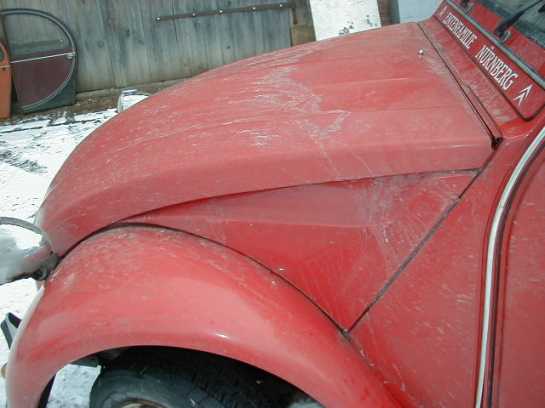|
Reasons
for rust
Some people say that Citroën
was the inventor of rust. This isn't totally true - FIAT also claims
to hold the patent for rust. ;)
The 2CV was not designed
to prevent rust
You have to keep in mind, that the basic design was made in the late
30's. At that time nobody thought of rust problems. Still it took long
to prevent rust from the design already. This started only in the
70's. Today's cars should have no places where dirt and water can be
collected. In the 2CV all these places permanently kept the humidity
on the metal. The result is rust.
Lousy material was used to make the 2CV
The rumor goes that after the war most of the steel was recycled with
lots of scrap metal. So the quality of the steel was poor. Therefore
the cars built in the 50's and 60's in Europe were not resistant
against rust.
The 2CV was designed as a cheap car, not made to last long
When Pierre Jules Boulanger did one of the first market researches in
history, he found out that the people needed a cheap and reliable car
with a good fuel economy. So the basic requirements for the design
were that the car should be affordable for an average income.
Lousy quality
The 2CV had to be cheap. In the beginning this concept worked out.
Over the years the production of cars got more sophisticated. The new
production plants worked more and more automatically. Robots assembled
and welded the cars. This of course requires a design that allows the
robot to do its job. The 2CV dated back to a time when an automatic
production was seen as science fiction. All the work had to be done
manually. This increased the production costs for the 2CV. So they had
to cut back on the costs. The result was less material and quality.
Over the years the metal became thinner and thinner. For example the
sheet metal used for the frame was only about half as thick as the
material used in the older 2CV's. Also less primer and paint was used.
In the last years of production on the inside of the car you could
sometimes see the primer trough the paint!
The biggest cutback in quality happened when Citroën moved the
2CV production to Portugal for the last three years of production. The
quality we got from there was absolutely lousy. A 2CV that was used
everyday and that did not receive a good rust protection in the
beginning, was unsafe to drive after 3 years already!
There is tons of salt on the roads in wintertime
Whenever the first frost and snow is expected, the road maintenance
crews start to throw tons of salt over all roads, especially on the
freeways. The asphalt turns white from the salt, so do the cars.
The salt gets everywhere in the frame and all over the body. It will
stay there a long time. As long as there is still salt left, it will
keep the water and corrode the steel.
So all unprotected spots are endangered. This is mainly true inside
the frame since there is almost no paint and no primer. The salty
water will creep between all the panels in the frame and work on their
disintegration. This photo was taken after about 60 mi on the
Autobahn. Before the car was washed and clean.

The roads
are white from salt - so are the cars
Standard wax doesn't work
The wax that is used for the standard protection will not really
help. This material is good for a flat surface, but the internal
structure is far away from this picture. The stability comes from the
horizontal reinforcements. They are spot welded to the top and bottom
panels. The wax will not get between these panels, since the space is
not big enough. The protection with wax is good for some time, but
after a few years the wax will dry out. The producer will promise you
that this never happens, but the experience tells a different story.
When you move the car, the whole body flexes. This makes the hard wax
to get very fine cracks. The saltwater is now actually sucked through
the cracks between these structures. When this happens, the wax even
works bad for the car. It will prevent the water from evaporating. So
the saltwater can work on the uncovered metal.
The panels were not painted with primer before they were welded
All the material used to build the body was not painted with a proper
primer. Then the welding was done. Many connections between panels
were sealed off with huge amounts of a rubber sealant.
After some years condensation will take place between the rubber and
the metal. This will destroy the unprotected metal in a long term.
This is the reason for the rust over the aluminum trim over the rear
fenders. Also the rust spots what you will find next to the taillights
are caused by this.
The 2CV's suffer from poor maintenance
Since the 2CV was seen as a very cheap car, the owners didn't care
much for maintenance. Mostly the cars were not washed and waxed. Even
worse, also the technical maintenance wasn't done. Most cars were just
been driven until they broke down. Subsequently the 2CV got a bad
reputation in reliability. This attitude only changed a few years
after the production was stopped, but that was too late for most cars.
|